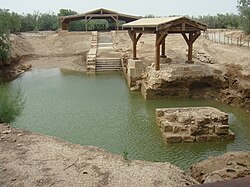Baptized
| Al-Maghtas | |
|---|---|
| Name as inscribed on the World Heritage List | |

Al-Maghtas ruins on the Jordanian side of the Jordan River are the location for the Baptism of Jesus and the ministry of John the Baptist.
|
|
| Location | Balqa Governorate Jordan |
| Type | Cultural |
| Criteria | iii, vi |
| Reference | 1446 |
| UNESCO region | Arab States |
| Inscription history | |
| Inscription | 2015 (39th Session) |
Baptism (from the Greek noun βάπτισμα baptisma; see below) is a Christian sacrament of admission and adoption, almost invariably with the use of water, into the Christian Church generally. The canonical Gospels report that Jesus was baptized—a historical event to which a high degree of certainty can be assigned. Baptism has been called a holy sacrament and an ordinance of Jesus Christ. In some denominations, baptism is also called christening, but for others the word "christening" is reserved for the baptism of infants. Baptism has also given its name to the Baptist churches and denominations, they being called Baptism as a whole.
The usual form of baptism among the earliest Christians was for the candidate to be immersed, either totally (submerged completely under the water) or partially (standing or kneeling in water while water was poured on him or her). While John the Baptist's use of a deep river for his baptism suggests immersion, "The fact that he chose a permanent and deep river suggests that more than a token quantity of water was needed, and both the preposition 'in' (the Jordan) and the basic meaning of the verb 'baptize' probably indicate immersion. In v. 16, Matthew will speak of Jesus 'coming up out of the water'. The traditional depiction in Christian art of John the Baptist pouring water over Jesus' head may therefore be based on later Christian practice." Pictorial and archaeological evidence of Christian baptism from the 3rd century onward indicates that a normal form was to have the candidate stand in water while water was poured over the upper body. Other common forms of baptism now in use include pouring water three times on the forehead, a method called affusion.
Martyrdom was identified early in Church history as "baptism by blood", enabling martyrs who had not been baptized by water to be saved. Later, the Catholic Church identified a baptism of desire, by which those preparing for baptism who die before actually receiving the sacrament are considered saved. As evidenced also in the common Christian practice of infant baptism, baptism was universally seen by Christians as in some sense necessary for salvation, until Huldrych Zwingli in the 16th century denied its necessity.
...
Wikipedia
